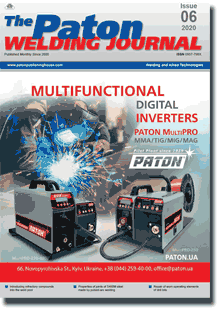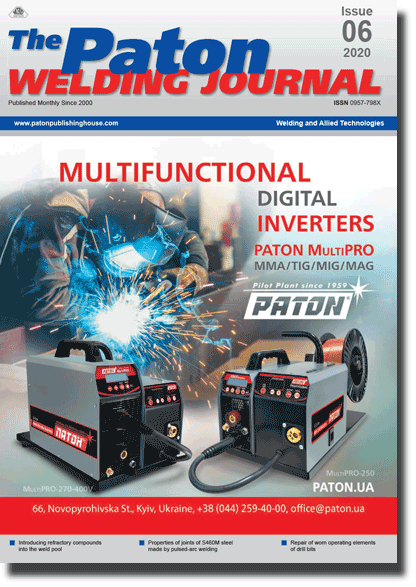| 2020 №06 (08) |
DOI of Article 10.37434/tpwj2020.06.01 |
2020 №06 (02) |

The Paton Welding Journal, 2020, #6, 2-8 pages
The influence of introducing refractory compounds into the weld pool on the weld metal dendritic structure
V.V. Holovko, D.Yu. Yermolenko and S.M. Stepanyuk
E.O. Paton Electric Welding Institute of the NAS of Ukraine 11 Kazymyr Malevych Str., 03150, Kyiv, Ukraine. E-mail: office@paton.kiev.ua
Abstract
A study was conducted in order to expand the knowledge base on the mechanisms of the influence of refractory compounds in the weld pool on modification of weld metal structure. Results of experiments on inoculation of TiN, SiC, NbC, VC, TiC, TiO2, Al2O3, MgO, ZrO2 dispersed particles to the liquid metal of the weld pool are given. Possibility of the influence of refractory inoculants as the melt «microcoolants», centers for epitaxial initiation of a new phase in the liquid metal and surface-active compounds on modification of the dendritic structure of the welds was analyzed. It is shown that under the conditions of welding low-alloyed steels by flux-cored wire of «metal core» type in shielding gas atmosphere, the refractory compounds, inoculated to the weld pool, the most actively influence modifying of the primary structure, as surface-active compounds. It is established that the change of dendrite morphology in the weld metal influences the temperature range of the recrystallization process, formation of secondary microstructure and mechanical properties of the welds. 10 Ref., 5 Tables, 8 Figures.
Keywords: low-alloyed steel, weld, refractory inclusions, dispersed particles, dendritic structure, modification, austenite grains
Received 26.10.2020
References
1. Yermolenko D.Yu., Holovko V.V., Stepanuyk S.M. (2018) Cellular automata for simulation of dendritic growth with surface active refractory inoculants. J. of Achievements in Materials and Manufacturing Eng., 88, Iss. 2, June, 49-54. https://doi.org/10.5604/01.3001.0012.61512. (2008) International standard ISO 14175:2008: Welding consumables — Gases and gas mixtures for fusion welding and allied processes.
3. (2008) International standard ISO 9692-1:2008: Welding and allied processes — Recommendations for joint preparation. Pt 1: Manual metal-arc welding, gas-shielded metal-arc welding, gas welding, TIG welding and beam welding of steels.
4. (2003) International standard ISO 17639:2003: Destructive tests on welds in metallic materials — Macroscopic and microscopic examination of welds.
5. (1990) IIW Doc. No.IX-1533−88: Guide to the light microscope examination of ferritic steel weld metals. Revue de la Soudure, 4, 29–41.
6. (2009) International standard ISO 15792-1:2009: Welding consumables –Test methods. Pt 1: Test methods for all-weld metal test specimens in steel, nickel and nickel alloys.
7. Gubenko, S.I., Parusov, V.V., Derevyanchenko, I.V. (2005) Nonmetallic inclusions in steel. Dnepropetrovsk, ART-Press [in Russian].
8. Zatulovsky, S.S. (1981) Suspension pouring. Kiev, Naukova Dumka [in Russian].
9. Gubenko, S.I., Oshkaderov, S.P. (2013) Nonmetallic inclusions in steel. Kiev, Naukova Dumka [in Russian].
10. Babaskin, Yu.Z. (1980) Structure and properties of cast steel. Kiev, Naukova Dumka [in Russian].
Suggested Citation
V.V. Holovko, D.Yu. Yermolenko and S.M. Stepanyuk (2020) The influence of introducing refractory compounds into the weld pool on the weld metal dendritic structure. The Paton Welding J., 06, 2-8.The cost of subscription/purchase order journals or individual articles
| Journal/Currency | Annual Set | 1 issue printed |
1 issue |
one article |
| TPWJ/USD | 384 $ | 32 $ | 26 $ | 13 $ |
| TPWJ/EUR | 348 € | 29 € | 24 € | 12 € |
| TPWJ/UAH | 7200 UAH | 600 UAH | 600 UAH | 280 UAH |
| AS/UAH | 1800 UAH | 300 UAH | 300 UAH | 150 UAH |
| AS/USD | 192 $ | 32 $ | 26 $ | 13 $ |
| AS/EUR | 180 € | 30 € | 25 € | 12 € |
| SEM/UAH | 1200 UAH | 300 UAH | 300 UAH | 150 UAH |
| SEM/USD | 128 $ | 32 $ | 26 $ | 13 $ |
| SEM/EUR | 120 € | 30 € | 25 € | 12 € |
| TDNK/UAH | 1200 UAH | 300 UAH | 300 UAH | 150 UAH |
| TDNK/USD | 128 $ | 32 $ | 26 $ | 13 $ |
| TDNK/EUR | 120 € | 30 € | 25 € | 15 € |
AS = «Automatic Welding» - 6 issues per year;
TPWJ = «PATON WELDING JOURNAL» - 12 issues per year;
SEM = «Electrometallurgy Today» - 4 issues per year;
TDNK = «Technical Diagnostics and Non-Destructive Testing» - 4 issues per year.


